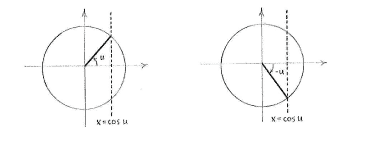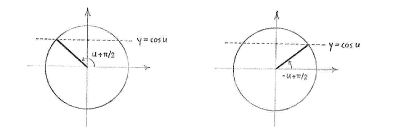Solution 4.4:7c
From Förberedande kurs i matematik 1
(Ny sida: {{NAVCONTENT_START}} <center> Bild:4_4_7c-1(3).gif </center> {{NAVCONTENT_STOP}} {{NAVCONTENT_START}} <center> Bild:4_4_7c-2(3).gif </center> {{NAVCONTENT_STOP}} {{NAVCONTENT_START}...) |
m |
||
| (4 intermediate revisions not shown.) | |||
| Line 1: | Line 1: | ||
| - | {{ | + | If we want to solve the equation <math>\cos 3x = \sin 4x</math>, we need an additional result which tells us for which values of ''u'' and ''v'' the equality |
| - | < | + | <math>\cos u = \sin v</math> holds, but to get that we have to start with the equality <math>\cos u=\cos v</math>. |
| - | {{ | + | |
| - | {{ | + | So, we start by looking at the equality |
| - | < | + | |
| - | {{ | + | {{Displayed math||<math>\cos u=\cos v\,\textrm{.}</math>}} |
| - | { | + | |
| - | < | + | We know that for fixed ''u'' there are two angles <math>v=u</math> and <math>v=-u</math> in the unit circle which have the cosine value <math>\cos u</math>, i.e. their ''x''-coordinate is equal to <math>\cos u\,</math>. |
| - | {{ | + | |
| + | [[Image:4_4_7_c1.gif|center]] | ||
| + | |||
| + | Imagine now that the whole unit circle is rotated anti-clockwise an angle <math>\pi/2</math>. The line <math>x=\cos u</math> will become the line <math>y=\cos u</math> and the angles ''u'' and -''u'' are rotated to <math>u+\pi/2</math> and <math>-u+\pi/2</math>, respectively. | ||
| + | |||
| + | [[Image:4_4_7_c2.gif|center]] | ||
| + | |||
| + | The angles <math>u+\pi/2</math> and <math>-u+\pi/2</math> therefore have their ''y''-coordinate, and hence sine value, equal to <math>\cos u</math>. In other words, the equality | ||
| + | |||
| + | {{Displayed math||<math>\cos u = \sin v</math>}} | ||
| + | |||
| + | holds for fixed ''u'' in the unit circle when <math>v = \pm u + \pi/2</math>, and more generally when | ||
| + | |||
| + | {{Displayed math||<math>v = \pm u + \frac{\pi}{2} + 2n\pi\qquad</math>(''n'' is an arbitrary integer).}} | ||
| + | |||
| + | For our equation <math>\cos 3x = \sin 4x</math>, this result means that ''x'' must satisfy | ||
| + | |||
| + | {{Displayed math||<math>4x = \pm 3x + \frac{\pi}{2} + 2n\pi\,\textrm{.}</math>}} | ||
| + | |||
| + | This means that the solutions to the equation are | ||
| + | |||
| + | {{Displayed math||<math>\left\{\begin{align} | ||
| + | x &= \frac{\pi}{2} + 2n\pi\,,\\[5pt] | ||
| + | x &= \frac{\pi}{14} + \frac{2}{7}\pi n\,, | ||
| + | \end{align}\right.</math>}} | ||
| + | |||
| + | where ''n'' is an arbitrary integer. | ||
Current revision
If we want to solve the equation
So, we start by looking at the equality
We know that for fixed u there are two angles
Imagine now that the whole unit circle is rotated anti-clockwise an angle 
 2
2
 2
2
 2
2
The angles 
 2
2
 2
2
holds for fixed u in the unit circle when  u+
u+
 2
2
 u+ u+ 2+2n 2+2n |
For our equation
 3x+ 3x+ 2+2n 2+2n . . |
This means that the solutions to the equation are
     xx= xx= 2+2n 2+2n  = = 14+72 14+72 n n |
where n is an arbitrary integer.


